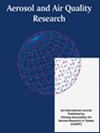医用口罩室内抗新冠肺炎效果的实验与计算分析
IF 2.5
4区 环境科学与生态学
Q3 ENVIRONMENTAL SCIENCES
引用次数: 0
摘要
通过实验结合计算分析,研究了KF94和ASTM 1级医用口罩在室内环境中的有效性。KF94掩膜样品的过滤效率最高(99.9%)。室内氯化钠(NaCl)液滴浓度平均< 4%,模拟结果与实验结果一致。紫外- c (UVC)辐照和干热样品在3个消毒处理循环后保持最高的过滤效率(> 97%)。所有方法(煮沸、蒸煮、乙醇处理和干热)均可有效减少金黄色葡萄球菌负荷99.99%。紫外辐射显示,在450µW cm-2下照射10分钟,可以有效去除口罩材料上的所有金黄色葡萄球菌。模拟结果表明,总体NaCl和CO2水平的降低与过滤效率成正比,重复使用面罩的有效性也与过滤效率成正比。气溶胶颗粒的替代指标(CO2)表明,非常细的呼吸道飞沫在达到稳定状态后可以穿透面罩。二氧化碳浓度的增加表明,气溶胶颗粒在充分通风的情况下积聚,并进一步构成感染的风险。NaCl液滴(2%)模拟表明,呼吸液滴已经渗透到面罩中,但面罩对NaCl液滴的阻挡和阻止能力更强。调查结果表明,有必要修订现有的控制政策条例。本文章由计算机程序翻译,如有差异,请以英文原文为准。
Experimental and Computational Analysis of Surgical Mask Effectiveness Against COVID-19 in Indoor Environment
An experiment coupled with a computational analysis was conducted to investigate the effectiveness of surgical masks, which include KF94 and ASTM Level 1, in an indoor environment. The KF94 mask sample shows the highest filtration efficiency (99.9%) in the analysis. The simulation is consistent with the experimental results as the concentration of sodium chloride (NaCl) droplets is < 4% on average in the room. The ultraviolet-C (UVC) irradiation and dry heating samples are shown to retain the highest filtration efficiencies (> 97%) after 3 disinfection treatment cycles. All methods (boiling, steaming, ethanol treatment, and dry heating) effectively reduce the S. aureus load by 99.99%. The UVC irradiation shows exposure to 450 µW cm-2 for 10 minutes can effectively eliminate all S. aureus on the mask materials. Simulation shows the reduction in overall NaCl and carbon dioxide (CO2) levels is directly proportional to the filtration efficiency and the effectiveness of reused masks is also directly proportional to the filtration efficiency. The proxy indicator (CO2) for aerosol particles demonstrates that very fine respiratory droplets can penetrate the mask after reaching a steady state. The CO2 concentration increase shows that aerosol particles are accumulated under adequate ventilation and further pose the risk of infection. The NaCl droplets (2%) simulation shows that respiratory droplets have infiltrated the mask, but the mask demonstrates a higher ability to block the NaCl droplets and prevent their penetration. The findings suggest a need to revise the existing regulation of the control policy.
求助全文
通过发布文献求助,成功后即可免费获取论文全文。
去求助
来源期刊

Aerosol and Air Quality Research
ENVIRONMENTAL SCIENCES-
CiteScore
8.30
自引率
10.00%
发文量
163
审稿时长
3 months
期刊介绍:
The international journal of Aerosol and Air Quality Research (AAQR) covers all aspects of aerosol science and technology, atmospheric science and air quality related issues. It encompasses a multi-disciplinary field, including:
- Aerosol, air quality, atmospheric chemistry and global change;
- Air toxics (hazardous air pollutants (HAPs), persistent organic pollutants (POPs)) - Sources, control, transport and fate, human exposure;
- Nanoparticle and nanotechnology;
- Sources, combustion, thermal decomposition, emission, properties, behavior, formation, transport, deposition, measurement and analysis;
- Effects on the environments;
- Air quality and human health;
- Bioaerosols;
- Indoor air quality;
- Energy and air pollution;
- Pollution control technologies;
- Invention and improvement of sampling instruments and technologies;
- Optical/radiative properties and remote sensing;
- Carbon dioxide emission, capture, storage and utilization; novel methods for the reduction of carbon dioxide emission;
- Other topics related to aerosol and air quality.
 求助内容:
求助内容: 应助结果提醒方式:
应助结果提醒方式:


